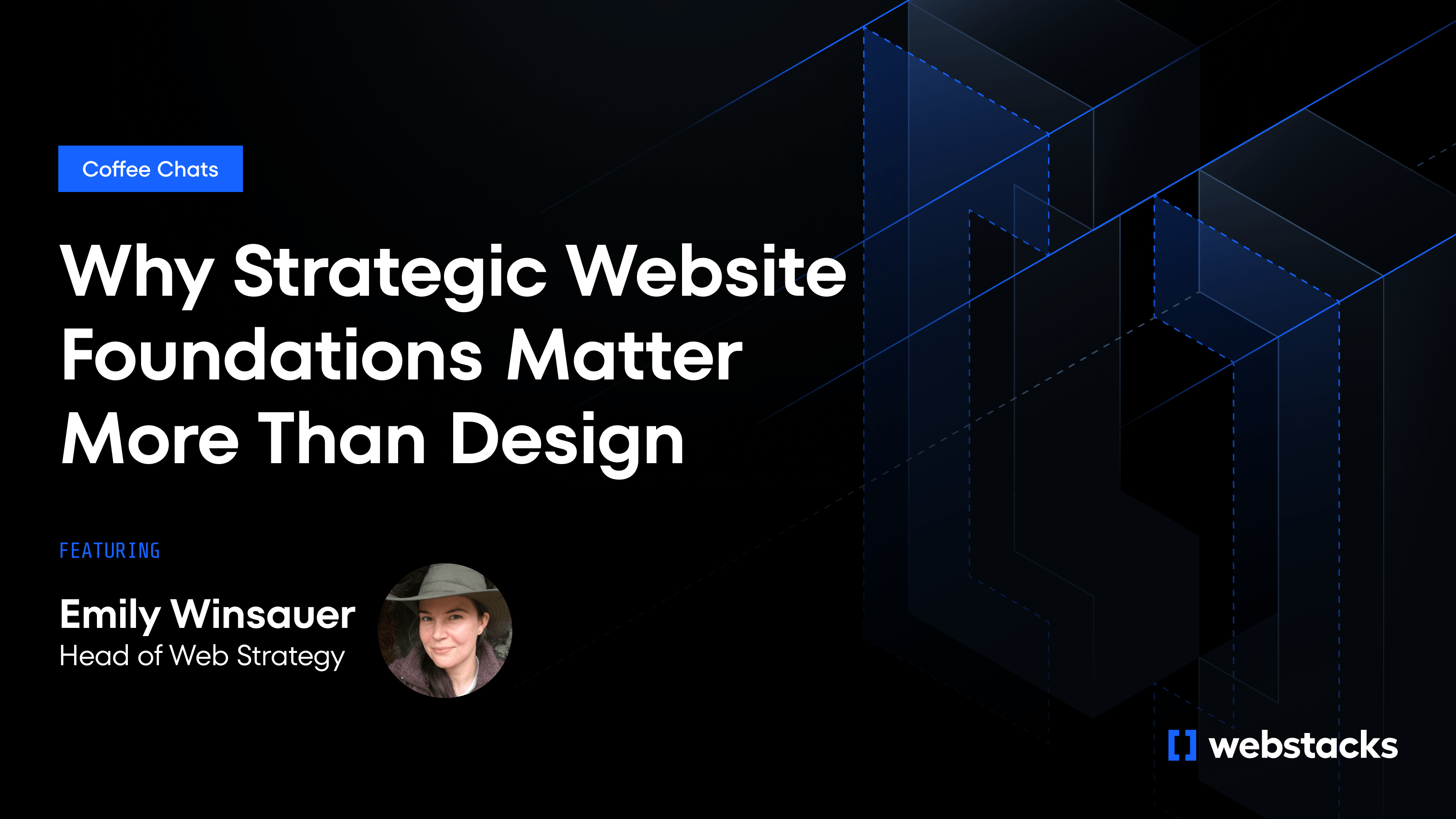For crypto exchange marketing, it used to be enough to drop a token, line up a few influencers, and watch the signups roll in. That playbook doesn’t work anymore.
Users are more selective now. They care about credibility, product experience, and how easy it is to get started. They want to know the platform won’t go down mid-trade. And they notice when a site feels clunky or outdated.
Meanwhile, internal teams are stretched. Marketing wants to move fast and growth wants cleaner funnels. And developers are juggling bugs, feature requests, and site updates they didn’t sign up for. When these things don’t line up, your marketing loses momentum.
This article is for crypto exchange teams that need users, volume, and a site that can keep up with their product. We’ll walk you through how to rethink your marketing, from the structure of your site to the way you speak to retail users, institutions, and developers. You’ll also learn how teams partner with Webstacks to build systems that scale without adding more friction.

1. Define the Exchange’s Core Audience and Use Case
Before launching campaigns or producing content, take the time to clarify exactly who you're trying to reach and what they're looking for.
Retail traders, institutional investors, and developers all have different expectations and decision-making triggers. A user-friendly mobile app might appeal to new retail investors, while institutional traders are more likely to prioritize regulatory compliance, liquidity, and reliability. If your messaging tries to cover everyone at once, it can become too generic to resonate with anyone.
This kind of misalignment often leads to friction: your signup flow doesn’t match user expectations, your content doesn’t answer the right questions, and marketing spend drives traffic that doesn’t convert.
The fix is to get specific. Define your primary audience and the core value you offer them. Are you:
- A regulated platform built for institutional traders?
- A DEX optimized for developers and protocol integrations?
- A mobile-first exchange focused on simplifying crypto for beginners?
That strategic choice should influence your messaging, content strategy, product UX, and even how your homepage is structured.
2. Build a Website That Earns Trust and Converts
In a crowded market, your website is often the first real interaction users have with your exchange. If that experience feels outdated or hard to trust, many users won’t give it a second chance, especially when there are dozens of alternatives just a click away.
The most common red flags include:
- Slow load times
- Poor mobile experience
- Vague messaging
- Confusing sign-up flow
- Missing trust signals like licensing, audits, or team info
When users land on your site, they need to quickly understand what your platform offers, who it’s for, and why it’s trustworthy. If that clarity is missing, conversion becomes an uphill battle.
We recommend our clients to treat the website as the front door to your product. It should reflect the quality, speed, and transparency that users expect from your platform.
We work with crypto teams to evolve from static marketing sites to dynamic systems that support long-term growth. That includes headless CMS setups such as Sanity, frontend frameworks like Next.js, and hosting with Vercel. Combined, they give you performance, flexibility, and the ability to publish content without depending on dev cycles.
3. Use Content to Rank, Educate, and Convert
For many exchanges, content ends up being an afterthought that’s often limited to press releases, price updates, or promotional announcements. But that kind of content rarely drives sustained growth or helps users take action.
The exchanges seeing real traction are using content strategically: to rank in search, educate different types of users, and guide them through conversion paths. The key is to understand what your users are actively looking for and build around those needs.
Start with search intent. What are users typing into Google when they’re exploring your platform or comparing you to others?
- “How to trade SOL on [your exchange]”
- “Is [your exchange] safe to use?”
- “Best crypto exchanges with low fees”
- “DEX vs. CEX: What’s the difference?”
These are high-intent moments. If your site offers a clear, helpful answer with a straightforward call to action, you’ll rank and build trust.
But content doesn’t stop at search. It plays a big role post-signup too. Once users are in the door, tutorials, token explainers, product guides, and onboarding walkthroughs help build confidence and keep users engaged.
4. Prioritize Technical SEO and Performance
For crypto exchanges, your website is a part of the user experience. Traders, developers, and token holders expect speed, clarity, and trust the moment they land on your site.
If your pages load slowly, feel clunky on mobile, or lack technical structure, users may leave before engaging and search engines may not rank your content at all.
Performance and technical SEO are foundational to everything else your team is trying to accomplish. They influence how well your site ranks, how long users stick around, and how effectively your content drives conversions.
Site Speed and Core Web Vitals
Google uses Core Web Vitals to evaluate how your site performs in real-world scenarios. These metrics measure loading speed (Largest Contentful Paint), interactivity (First Input Delay), and visual stability (Cumulative Layout Shift). Meeting these benchmarks is especially important in crypto, where users often come from X links, mobile browsers, or aggregator sites and expect near-instant load times.
To improve site speed, your team should consider using modern frameworks such as Next.js, which support static site generation and faster page rendering. Deploying your site on a platform like Vercel ensures global CDN coverage, reducing latency no matter where your users are.
You should also optimize large assets like hero images or videos, defer non-essential scripts, and use lazy loading where appropriate.
Mobile Optimization
Many users discover crypto products through mobile-first channels such as Twitter, Telegram, or Discord. However, many exchange sites are still designed with desktop in mind, which leads to poor experiences on mobile devices.
Every element—from your navigation and signup flow to your token detail pages—should be tested across a variety of screen sizes and devices. Use responsive design principles, mobile-friendly touch targets, and accessible text sizes to ensure the experience is usable and intuitive on any device.
Crawlability and Indexing
No matter how valuable your content is, it won’t drive traffic if search engines can’t access or understand it. Crawlability and indexing are often overlooked in fast-moving teams, but they are key to long-term search visibility.
Your team should ensure that all key content is included in an accurate sitemap and that nothing important is accidentally blocked in your robots.txt file.
Pages should be structured with semantic HTML, clear headings, and accessible markup. Avoid JavaScript-heavy rendering for content that needs to be discoverable—Google can handle some of it, but relying too much on client-side scripts can reduce visibility in search.
Script and Plugin Management
Over time, marketing and product teams often add plugins and scripts that slow down the site without offering real value. These may include old tracking tools, duplicate analytics tags, or multiple third-party widgets.
Teams should regularly audit third-party scripts and remove anything that is no longer necessary. Where possible, defer loading non-critical scripts until after the initial page load.
If you’re using tag managers, make sure they are configured efficiently to avoid introducing latency or privacy issues.
Scalable Architecture and Content Management
Fast performance doesn’t just come from technical cleanup—it also depends on how your site is structured behind the scenes. As your team grows and your content library expands, it’s important to have a system that supports iteration without slowing down performance.
Using a headless CMS gives your team structured content and flexible publishing workflows. Paired with a modular design system, it allows marketers to update pages or launch campaigns without depending on developers. It also helps reduce duplication and support multilingual or regionalized content as your exchange scales.
At Webstacks, we work with crypto teams to build performance-first websites that support SEO, UX, and long-term growth. When technical SEO and performance are treated as core parts of your strategy, you get a site that is faster, easier to update, and more capable of converting users at every stage.
If you’re not sure where your current setup stands, it may be time to conduct a technical audit. Even small improvements in performance can have a meaningful impact across the entire user journey.

5. Make Developer Onboarding Easy
Developer onboarding is a key part of growth. When technical users can quickly understand how your tools work, they're more likely to stick around. Unlike paid traffic, developer adoption tends to compound over time. Once someone integrates your API, deploys a smart contract, or joins your ecosystem, they’re invested.
To support that kind of momentum, the onboarding experience needs to be accessible and easy to navigate. A few elements make a big difference:
- A clearly labeled “Developers” section in your main navigation
- Fast-loading, well-organized documentation that’s easy to read
- Copy-paste-ready code samples in multiple languagesSandbox environments or API dashboards for testing without frictionSEO-optimized docs so developers can find answers through search
You don’t need to overengineer this, just design it with the same care you’d apply to your main site or user app. It should be clear how documentation connects to your core use cases, how developers can get started quickly, and where they can go for support.
6. Activate the Right Channels for Growth
Not every channel fits every product or audience, and trying to cover everything at once can stretch your team thin and dilute your impact. A more effective approach is to focus on the few channels that align with your users and your current stage of growth.
For retail users, you’re typically trying to build trust, simplify onboarding, and get users to make their first trade. What helps is:
- Paid search and display
- Referral bonuses
- Influencer-led explainers on YouTube or X
- Educational blog content
For institutions, the sales cycle is slower and more technical. The focus shifts to credibility and performance:
- Whitepapers or technical audits
- Dedicated landing pages with licensing details
- Compliance-focused content
- Email workflows tied to product demos
For developers, community is the channel. They want tools, such as:
- Open-source repos
- Hackathons and bounties
- Docs that rank in Google
- Dev-focused X threads or Discord AMAs
Before launching any campaign, it's worth asking: who exactly are we trying to reach, and what action do we want them to take? When your channel strategy is aligned with user intent and product maturity, you’ll see stronger engagement and more measurable impact.
7. Build a System That Grows With You
Early-stage infrastructure can get the job done when your team is small and campaigns are infrequent. But as your exchange grows, that same setup can quickly become a source of friction.
It’s a common scenario: Marketing wants to launch a new landing page, but development resources are tied up with product work. A bug in the signup flow is flagged, but there’s no clear ownership. A blog post is ready to go, but sits in review because publishing still requires manual updates from engineering. These bottlenecks slow down growth and make it harder to move at the pace your product demands.
As teams scale, they need a system that allows marketers, designers, and developers to work in parallel without stepping on each other.
A scalable setup usually includes:
- A headless CMS that gives non-technical teams control over publishing and page updates
- A design system that ensures visual consistency
- Developer workflows that support version control, CI/CD, and modular codebases—making it easier to ship changes without breaking the site
Separating content, design, and code allows each team to move faster without creating unnecessary dependencies. It also helps maintain a clean, high-performing site even as more people contribute to it.
For crypto teams, where product timelines can shift quickly and campaigns often hinge on external events, this kind of system makes a measurable difference. It reduces time-to-launch and improves cross-team coordination.
If your current setup feels brittle or too dependent on a few key contributors, it may be time to invest in a more modular foundation.
At Webstacks, we help teams migrate to modular stacks that separate content, design, and code.
We helped Solana move to Builder.io and rebuild their design system so marketing could ship updates without pulling in engineers every time.
Work With a Team That Moves as Fast as You Do
When your site can’t keep up, it slows everything down. Crypto teams often try to power through with the resources they have. But that only works for so long. At some point, the site starts getting in the way of the product instead of supporting it.
That’s usually when teams bring in Webstacks. We don’t just handle design and development—we help you build a system that supports real marketing work. The kind where:
- Pages go live without engineering involvement
- Campaigns ship faster
- Performance issues stop getting in the way
We’ve worked with exchanges, protocols, and Web3 platforms to rebuild sites that match their pace. If you’re spending more time maintaining your site than growing through it, let’s talk.




